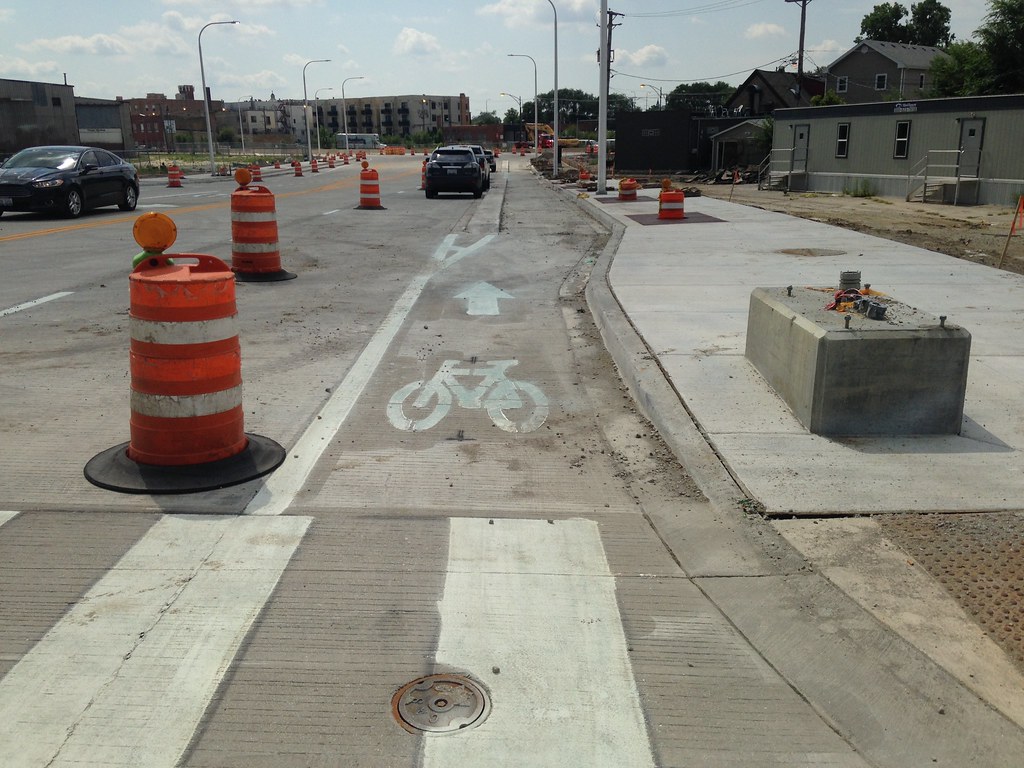
During last week's Mayor's Bicycle Advisory Council meeting Chicago Department of Transportation staffers shared a number of updates on the city's bike network.
At the event, CDOT planner Mike Amsden, who manages the department's bikeways program, explained how funds from Blue Cross Blue Shield's $12 million sponsorship of the Divvy bike-share system are helping to pay for bike lane maintenance.
While new Chicago bikeways are often paid for by federal Congestion Mitigation and Air Quality Improvement grants, this money can't be used to repair existing bike lanes. Therefore funding for restriping faded lanes has to be cobbled together from various sources, which is why many bikeways shown on the city's bike map are actually faded to near-invisibility.
A primary source for bike lane maintenance is CDOT's Arterial Resurfacing program, paid for by state and federal funds. When a street is repaved through this program, CDOT will use the funding to restripe existing bike lanes or, if deemed appropriate, add new bikeways.
Another potential funding source for restriping is the $1.32 million in discretionary "menu" money allocated annually to each of Chicago's 50 wards, but only a fraction of the wards have opted to spend the funding that way. From 2012 to 2015, only nine aldermen or participatory budgeting elections allocated menu money for bike lane restriping or construction, spending a grand total of less than $1 million, according to a review of menu expenditures posted on the city's Office of Management and Budget website. That was less than 0.4 percent of the $264 million in menu funds available to all 50 aldermen during that four-year period.
Fortunately, in recent years CDOT has been using a significant amount of the Blue Cross sponsorship for bike lane maintence. From 2014 (when sponsorship started) to 2016, about $2 million of that $12 million has been earmarked for restriping, according to CDOT spokesman Mike Claffey. He said that those funds pay for restriping of all markings on the affected street – including crosswalks and center-line stripes as well as the bike lanes – "to make it safer for everyone."
Several important downtown bike lane streets that are currently in terrible shape due to construction projects will be repaved soon:
- Kinzie from Desplaines to Wells – scheduled for mid-September
- Dearborn from Madison to Wacker – scheduled for mid-September
- Randolph between Michigan and Clinton – construction started last week
Amsden also discussed new bike lane construction, and upgrades to existing bikeways, that are currently in progress or slated to begin very soon. These projects include three miles of brand-new or improved protected bike lanes, including some stretches of curb protection and special treatments at intersections.
On Franklin Boulevard between Sacramento and Central Park in Humboldt Park, the existing protected lanes – located curbside in the boulevard's center drive and aside delineated flexible posts – were removed as part of a street repaving project. The protected lanes will soon be rebuilt with some concrete protection, Amsden said.

As part of the redesign of the Fullerton/Damen/Elston intersection north of Bucktown, Elston Avenue has been moved north and east to bypass the intersection of Fullerton and Damen. Fully curb-protected bike lanes are being added to the new curved stretch of Elston and the lanes are nearly finished. Check out our recent post about that project here.
Randolph in the Loop will also be getting a protected bike lane as part of the resurfacing project.
CDOT is also working on striping 14 miles of buffered bike lanes, which have additional striping on one or both sides of the bike lane to help keep cyclists away from moving traffic and/or opening car doors. These include a 2.6-mile segment buffered lanes of Cottage Grove from 95th and 115th. Amsden said that new bikeway will connect with five Metra stations and carry bicyclists to the Pullman Historic District, which was designated as a national monument last year.
Other bikeway projects planned for completion this year include an extension of the Wood Street neighborhood greenway, which currently runs from Milwaukee to Augusta in Wicker Park and Ukrainian Village, south to Hubbard. The Wood greenway may also be extended north to Cortland in 2017, and a neighborhood greenway may be added on Cortland from Damen to Ashland.
The department also plans to build a new neighborhood greenway on Glenwood Avenue from Broadway to Ridge in Edgewater, including a southbound contraflow lane. The Glenwood greenway will eventually be extended north through Rogers Park to the Evanston border.
CDOT is also designing new neighborhood greenways on School and Roscoe Streets in Lakeview, from Lincoln Ave. to the Lakefront Trail. They also plan to create a connection from the south end of the Dearborn two-way protected bike lane at Polk to 9th and Michigan.
Finally, CDOT is still working on designs for a proposed neighborhood greenway on Manor Ave. in Ravenswood Manor, which Amsden said was one of the most controversial projects. We'll have more details on that story tomorrow.




